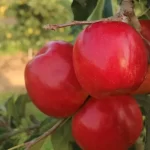Lilibet, a brand new variety of apple that hails from Italy has been introduced. The launch was a result of partnerships involving an agreement by CIV as well as CIV and the Piedmontese company Sanifrutta an agricultural cooperative that has two warehouses located in Costigliole Saluzzo and Verzuolo in Italy. It was intended to initiate an experiment for the eventual creation of a club exclusive initiative in Italy that would be based on the Lilibet(r)/CIVM35Apple tree.
This bicolour selection of early apple, that matures 5 days prior to the Gala and is distinguished by its vivid red hue and a particularly sweet, nutty and succulent flesh. The distribution will be able to appreciate its excellent shelf longevity of this variety. It ensures excellent performance in conservation.
Alex Tallone, Head of the Technical Office and Technological Development of Sanifrutta reports on the research that resulted in the final conclusion: “The current challenges of increasing the number of apple trees are a result of weather and environmental factors, related to the climate changes. Lilibet has a variety of characteristics which make it suitable to farming challenges and is located within the foothills in which the vibrant red color of the apple stands out in a stunning way, and also provides an outstanding reaction to what is known as easy to cultivate>> which is a crucial aspect for the contemporary apple farmer”.
The high scab resistance of this model is a great option for those who put sustainability as the primary goal of their business. Production takes significant advantage of the simplicity of management for the plant, as it features a lower sensitivity to different bearing.
Eraldo Barale, CEO of Sanifrutta has expressed his delight of the outcome “This kind of apple is very good in terms of taste perspective and has a beautiful appearance which gives it a huge advantage of being able to enter the market earlier for apple”. This collaboration with Sanifrutta can allow the two companies to draw on the strengths of each other for greater efficiency and speedier collaborative development and increase in both agronomic and productivity outcomes.
The experience is crucial for Federico Stanzani, Commercial Director of CIV This experience is crucial for the market of apples: “The partnership with Sanifrutta originated from the concept to develop a plan which could be able to bring real innovation in the field of apples. Lilibet quickly proved to be a suitable fruit for the job and enabled us to develop an extensive program to the Italian market because of the capabilities of CIV together with its partners as well as of Sanifrutta. We’re delighted to announce the start of this collaboration as well as a powerful synergies that will help both firms to meet amazing goals in the coming couple of months,” concludes Stanzani.
For additional information, click here:
Consorzio Italiano Vivaisti
TEL +39 0533 399431
E-mail: [email protected]
www.civ.it
